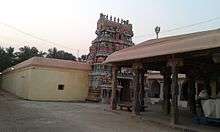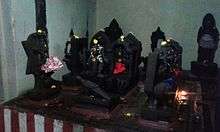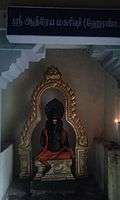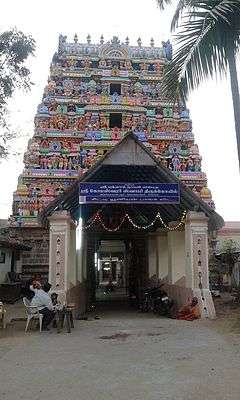Kottaiyur Kodeeswarar Temple
| Kodeeswarar Temple | |
|---|---|
|
Image of the Kodeeswarar temple gopuram | |
 Kodeeswarar Temple Location in Tamil Nadu | |
| Geography | |
| Coordinates | 10°58′00″N 79°21′30″E / 10.96667°N 79.35833°ECoordinates: 10°58′00″N 79°21′30″E / 10.96667°N 79.35833°E |
| Country | India |
| State | Tamil Nadu |
| District | Thanjavur |
| Location | Kottaiyur |
| Culture | |
| Primary deity | Kodeeswarar(Shiva) |
| Consort | Pandhadu Nayagi(Parvathi) |
| Architecture | |
| Architectural styles | Dravidian architecture |
Kottaiyur Kodeeswarar Temple is a Hindu temple dedicated to Shiva, located in Kottaiyur, a village in the outskirts of Kumbakonam, in Thanjavur district in Tamil Nadu, India. Shiva is worshipped as Koteeswarar and his consort Parvathi as Pandhadu Nayaki. Koteeswarar is revered in the 7th century Tamil Saiva canonical work, the Tevaram, written by Tamil saint poets known as the Nayanmars and classified as Paadal Petra Sthalam, the 275 temples revered in the canon.
The temple has a five-tiered rajagopuram, the entrance tower and all the shrines are enclosed in rectangular walls. The temple has four daily rituals at various times from 6:00 a.m. to 8 p.m., and three yearly festivals on its calendar, namely Margazhi Tiruvathirai during the Tamil month of Margazhi (December - January), Shivaratri in February- March, Panguni Uthiram during Panguni (March - April) and Arrow festival during Purattasi (September - October) being the most prominent. The temple is maintained and administered by the Hindu Religious and Endowment Board of the Government of Tamil Nadu.[1]
Legend

As per Hindu legend, Suruchi, the son of Sathyarthi, the ruler of Trihartha kingdom, took the form of a devil on account of a curse. On account of disfigure, people ran away on seeing him. He prayed to Shiva and was advised to take a holy dip in the spring in the temple. He got his original form and the belief is followed in modern times, where ladies take a holy dip to get a better appearance. As per another legend, sage Herandar (Athreya) is believed to have worshipped Shiva at this place.[2] Pandhadu Nayagi, meaning Goddess playing with a ball, got her name as she is believed to toss the curses of devotees off their suffering. Shiva is believed to have appeared in ten million (called kodi in Tamil) forms of Vinayaga, Parvathi and Muruga and hence got Koteeswarar as his name.[1]
Architecture

The temple is located 5 km (3.1 mi) north-west of Kumbakonam on the Kumbakonam - Swamimalai road. Kodeeswarar temple has a rectangular plan with two prakarams (outer courtyard) covering an area of 1 acre (0.40 ha) and a five-tiered rajagopuram (gateway tower) facing East. The central shrine faces east and houses the image of Kodeeswarar (Shiva) in the form of lingam made of granite. There is a separate shrine for Vinayagar and Murugan on both sides of the entrance to the sanctum. The granite images of Nandi (the bull and vehicle of Shiva), a tall flag staff and a Balipeeta, the place of offering, axial to the sanctum. As in other Shiva temples of Tamil Nadu, the first precinct or the walls around the sanctum of Kodeeswarar has images of Dakshinamurthy (Shiva as the Teacher), Durga (warrior-goddess) and Chandikeswarar (a saint and devotee of Shiva). The temple precinct is surrounded by granite walls. The images of Navagraha, the planetary deities is unique that they are depicted with all their chariots.[1]
Worship and religious practises

The temple priests perform the puja (rituals) during festivals and on a daily basis. The temple rituals are performed four times a day; Kalasanthi at 7:30 a.m., Uchikalam at 11:30 a.m., Sayarakshai at 6:00 p.m and Arthajamam at 8:00 p.m.. Each ritual comprises four steps: abhisheka (sacred bath), alangaram (decoration), naivethanam (food offering) and deepa aradanai (waving of lamps) for Koteeswarar and Pandadu Nayagi. There are weekly rituals like somavaram (Monday) and sukravaram (Friday), fortnightly rituals like pradosham, and monthly festivals like amavasai (new moon day), kiruthigai, pournami (full moon day) and sathurthi. Margazhi Tiruvathirai during the Tamil month of Margazhi (December - January), Shivaratri in February- March, Panguni Uthiram during Panguni (March - April) and Arrow festival during Purattasi (September - October) are the four festivals celebrated in the temple.[1]
Religious significance
It is one of the shrines of the 275 Paadal Petra Sthalams - Shiva Sthalams glorified in the early medieval Tevaram poems by Tamil Saivite Nayanar Tirunavukkarasar. Tirunavukkarasar describes the feature of the deity of Kottaiyur and Tiruvalanchuzhi as:[3]
| “ | பொடியாடு மேனிப் புனிதன் கண்டாய் புட்பாகற் காழி கொடுத்தான் கண்டாய் இடியார் கடுமுழக்கே றூர்ந்தான் கண்டாய் எண்டிசைக்கும் விக்காகி நின்றான் கண்டாய் |
” |
The Mahasamprokshanam also known as Kumbabishegam (consecration) of the temple was held on 26th October 2015. [4]
References
- 1 2 3 4 "Sri Koteeswarar, Kailasanathar temple temple". Dinamalar. 2014. Retrieved 24 November 2015.
- ↑ Ayyar, P. V. Jagadisa (1991). South Indian shrines: illustrated. New Delhi: Asian Educational Services. p. 246. ISBN 81-206-0151-3.
- ↑ Tirunavukkarasar Tevaram, VI: 73:4
- ↑ "Vedaranyeswarar temple 'kumbhabhishekam' draws thousands". The Hindu. 2015-10-27. Retrieved 2015-10-28.
External links
- "Kodeeswarar Temple, Tirukkottaiyur". Shiva Temples of Tamil Nadu, Paadal Petra Sivasthalangal.
| Wikimedia Commons has media related to Koteeswarar temple. |
